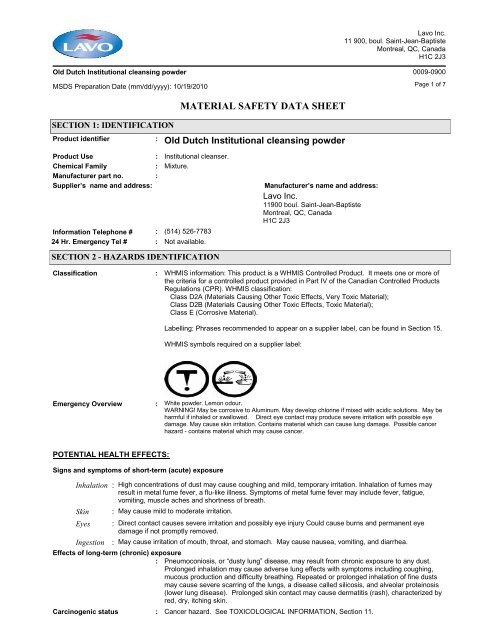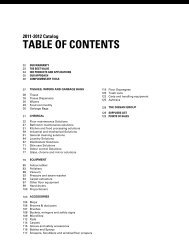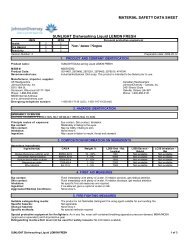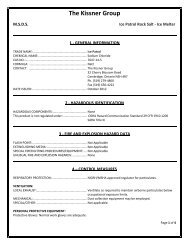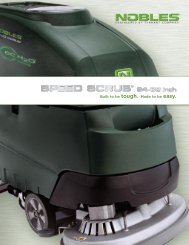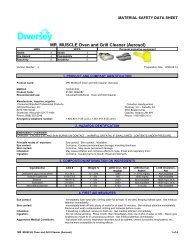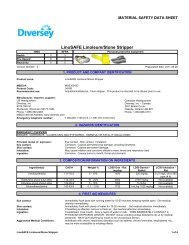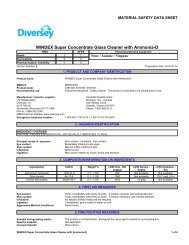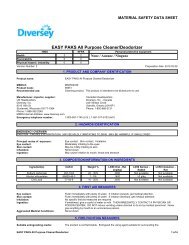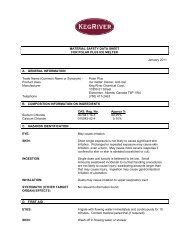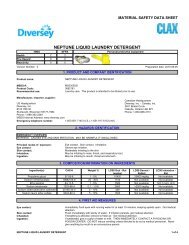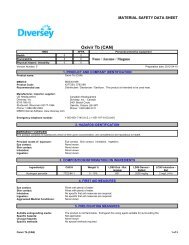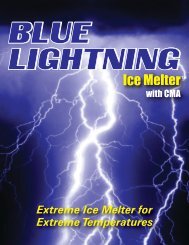MATERIAL SAFETY DATA SHEET - Groupe Sani Marc
MATERIAL SAFETY DATA SHEET - Groupe Sani Marc
MATERIAL SAFETY DATA SHEET - Groupe Sani Marc
Create successful ePaper yourself
Turn your PDF publications into a flip-book with our unique Google optimized e-Paper software.
Lavo Inc.<br />
11 900, boul. Saint-Jean-Baptiste<br />
Montreal, QC, Canada<br />
H1C 2J3<br />
Old Dutch Institutional cleansing powder 0009-0900<br />
MSDS Preparation Date (mm/dd/yyyy): 10/19/2010<br />
Page 1 of 7<br />
<strong>MATERIAL</strong> <strong>SAFETY</strong> <strong>DATA</strong> <strong>SHEET</strong><br />
SECTION 1: IDENTIFICATION<br />
Product identifier<br />
: Old Dutch Institutional cleansing powder<br />
Product Use<br />
: Institutional cleanser.<br />
Chemical Family<br />
: Mixture.<br />
Manufacturer part no. :<br />
Supplier’s name and address:<br />
Information Telephone # : (514) 526-7783<br />
24 Hr. Emergency Tel # : Not available.<br />
SECTION 2 - HAZARDS IDENTIFICATION<br />
Manufacturer’s name and address:<br />
Lavo Inc.<br />
11900 boul. Saint-Jean-Baptiste<br />
Montreal, QC, Canada<br />
H1C 2J3<br />
Classification<br />
: WHMIS information: This product is a WHMIS Controlled Product. It meets one or more of<br />
the criteria for a controlled product provided in Part IV of the Canadian Controlled Products<br />
Regulations (CPR). WHMIS classification:<br />
Class D2A (Materials Causing Other Toxic Effects, Very Toxic Material);<br />
Class D2B (Materials Causing Other Toxic Effects, Toxic Material);<br />
Class E (Corrosive Material).<br />
Labelling: Phrases recommended to appear on a supplier label, can be found in Section 15.<br />
WHMIS symbols required on a supplier label:<br />
Emergency Overview<br />
:<br />
White powder. Lemon odour.<br />
WARNING! May be corrosive to Aluminum. May develop chlorine if mixed with acidic solutions. May be<br />
harmful if inhaled or swallowed. Direct eye contact may produce severe irritation with possible eye<br />
damage. May cause skin irritation. Contains material which can cause lung damage. Possible cancer<br />
hazard - contains material which may cause cancer.<br />
POTENTIAL HEALTH EFFECTS:<br />
Signs and symptoms of short-term (acute) exposure<br />
Inhalation<br />
Skin<br />
Eyes<br />
:<br />
:<br />
:<br />
Ingestion :<br />
High concentrations of dust may cause coughing and mild, temporary irritation. Inhalation of fumes may<br />
result in metal fume fever, a flu-like illness. Symptoms of metal fume fever may include fever, fatigue,<br />
vomiting, muscle aches and shortness of breath.<br />
May cause mild to moderate irritation.<br />
Direct contact causes severe irritation and possibly eye injury Could cause burns and permanent eye<br />
damage if not promptly removed.<br />
May cause irritation of mouth, throat, and stomach. May cause nausea, vomiting, and diarrhea.<br />
Effects of long-term (chronic) exposure<br />
: Pneumoconiosis, or “dusty lung” disease, may result from chronic exposure to any dust.<br />
Prolonged inhalation may cause adverse lung effects with symptoms including coughing,<br />
mucous production and difficulty breathing. Repeated or prolonged inhalation of fine dusts<br />
may cause severe scarring of the lungs, a disease called silicosis, and alveolar proteinosis<br />
(lower lung disease). Prolonged skin contact may cause dermatitis (rash), characterized by<br />
red, dry, itching skin.<br />
Carcinogenic status<br />
:<br />
Cancer hazard. See TOXICOLOGICAL INFORMATION, Section 11.
Lavo Inc.<br />
11 900, boul. Saint-Jean-Baptiste<br />
Montreal, QC, Canada<br />
H1C 2J3<br />
Old Ducth Institutional cleansing Powder 0009-0900<br />
MSDS Preparation Date (mm/dd/yyyy): 10/19/2010<br />
Page 2 of 7<br />
Additional health hazards : See TOXICOLOGICAL INFORMATION, Section 11.<br />
Potential environmental effects<br />
:<br />
This product contains marine pollutants. See ECOLOGICAL INFORMATION, Section 12.<br />
SECTION 3 - COMPOSITION/INFORMATION ON INGREDIENTS<br />
Ingredients CAS # Wt.%<br />
Calcium carbonate<br />
Sodium carbonate<br />
Sodium dodecylbenzenesulfonate<br />
C10-16 Monoalkylbenzene sulfonic acid,<br />
sodium salt<br />
Magnesium oxide<br />
Crystalline silica, quartz<br />
Sodium dichloroisocyanurate<br />
1317-65-3<br />
497-19-8<br />
25155-30-0<br />
68081-81-2<br />
1309-48-4<br />
14808-60-7<br />
2893-78-9<br />
80.00 - 100.00<br />
7.00 - 13.00<br />
1.00 - 5.00<br />
1.00 - 5.00<br />
1.00 - 5.00<br />
0.50 - 1.50<br />
0.10 - 1.00<br />
SECTION 4 - FIRST AID MEASURES<br />
Inhalation<br />
:<br />
Immediately remove person to fresh air. If breathing has stopped, give artificial respiration. If<br />
breathing is difficult, give oxygen by qualified medical personnel only. Get medical attention.<br />
Skin contact : Remove/Take off immediately all contaminated clothing. Wash exposed area thoroughly<br />
with soap and water for at least 15 minutes. Get medical attention.<br />
Eye contact : Immediately flush eyes with running water for at least 20 minutes. Seek immediate<br />
medical attention/advice.<br />
Ingestion<br />
: Do not induce vomiting. Get medical attention. Never give anything by mouth to an<br />
unconscious person.<br />
Notes For Physician<br />
:<br />
Treat symptomatically.<br />
SECTION 5 - FIRE FIGHTING MEASURES<br />
Fire hazards/conditions of flammability<br />
: Not flammable under normal conditions of use. Closed containers may rupture if exposed to<br />
excess heat or flame due to a build-up of internal pressure. During a fire, irritating and toxic<br />
gases may be generated by thermal decomposition or combustion. May develop chlorine if<br />
mixed with acidic solutions.<br />
Oxidizing properties<br />
: None known.<br />
Explosion data: Sensitivity to mechanical impact / static discharge<br />
: Not expected to be sensitive to mechanical impact or static discharge.<br />
Suitable extinguishing media : Use media suitable to the surrounding fire such as water fog or fine spray, alcohol foams,<br />
carbon dioxide and dry chemical.<br />
Special fire-fighting procedures/equipment<br />
: Firefighters should wear proper protective equipment and self-contained breathing<br />
apparatus with full face piece operated in positive pressure mode. Move containers from fire<br />
area if safe to do so. Water spray may be useful in cooling equipment exposed to heat and<br />
flame.<br />
Hazardous combustion products<br />
: Carbon oxides; calcium oxide; Sodium oxides; metal oxides; chlorine; Phosgene; Nitrogen<br />
oxides (NOx); Chlorinated hydrocarbon; Other unidentified organic compounds.<br />
SECTION 6 - ACCIDENTAL RELEASE MEASURES<br />
Personal precautions :<br />
All persons dealing with the clean-up should wear the appropriate chemically protective<br />
equipment. Keep all other personnel upwind and away from the spill/release. Restrict<br />
access to area until completion of clean-up. Refer to protective measures listed in sections 7<br />
and 8.
Lavo Inc.<br />
11 900, boul. Saint-Jean-Baptiste<br />
Montreal, QC, Canada<br />
H1C 2J3<br />
Old Dutch Institutional cleansing powder 0009-0900<br />
MSDS Preparation Date (mm/dd/yyyy): 10/19/2010<br />
Page 3 of 7<br />
Environmental precautions :<br />
Spill response/cleanup :<br />
Prohibited materials<br />
:<br />
Ensure spilled product does not enter drains, sewers, waterways, or confined spaces.<br />
Ventilate area of release. Remove all sources of ignition. Vacuum or sweep up spilled<br />
material using a method that does not generate airbourne dust. Place spilled material into a<br />
suitable, labelled container for later disposal (see Section 13). Flush area with water. Do not<br />
flush into surface water or sanitary sewer system. Notify the appropriate authorities as<br />
required.<br />
None known.<br />
SECTION 7 - HANDLING AND STORAGE<br />
Safe Handling procedures :<br />
Use in a well-ventilated area. Wear suitable protective equipment during handling. Do not<br />
breathe dust. Avoid contact with skin, eyes and clothing. Keep away from extreme heat and<br />
flame. Keep away from acids and other incompatibles. Avoid and control operations which<br />
create dust. Keep containers closed when not in use. Wash thoroughly after handling.<br />
Empty containers retain residue (liquid and/or vapour) and can be dangerous.<br />
Storage requirements :<br />
Store in a cool, dry, well-ventilated area. Storage area should be clearly identified, clear of<br />
obstruction and accessible only to trained and authorized personnel. Inspect periodically for<br />
damage or leaks. Keep away from incompatibles. Avoid contact with aluminum.<br />
Incompatible materials : Acids; Aluminum; Halogenated compounds; Oxidizing agents; Reducing agents.<br />
Special packaging materials : Always keep in containers made of the same materials as the supply container.<br />
SECTION 8 - EXPOSURE CONTROLS AND PERSONAL PROTECTION<br />
Exposure Limits<br />
ACGIH TLV<br />
OSHA PEL<br />
Ingredients<br />
TWA<br />
STEL<br />
PEL<br />
STEL<br />
Calcium carbonate<br />
N/Av<br />
N/Av<br />
15 mg/m³ (Total<br />
dust);<br />
5 mg/m³ (respirable)<br />
N/Av<br />
Sodium carbonate<br />
N/Av<br />
N/Av<br />
N/Av<br />
N/Av<br />
Sodium dodecylbenzenesulfonate<br />
N/Av<br />
N/Av<br />
N/Av<br />
N/Av<br />
C10-16 Monoalkylbenzene sulfonic<br />
acid, sodium salt<br />
N/Av<br />
N/Av<br />
N/Av<br />
N/Av<br />
Magnesium oxide<br />
Crystalline silica, quartz<br />
(inhalable) 10 mg/m³<br />
0.025 mg/m³<br />
(respirable)<br />
N/Av<br />
N/Av<br />
15 mg/m³ (total<br />
particulate)<br />
0.1 mg/m³<br />
(respirable) (final<br />
rule limit)<br />
N/Av<br />
N/Av<br />
Sodium dichloroisocyanurate<br />
N/Av<br />
N/Av<br />
N/Av<br />
N/Av<br />
Ventilation and engineering measures<br />
: Use in a well-ventilated area. Use general or local exhaust ventilation to maintain air<br />
concentrations below recommended exposure limits.<br />
Respiratory protection : If the TLV is exceeded, a NIOSH/MSHA-approved respirator is advised. Advice should be<br />
sought from respiratory protection specialists.<br />
Skin protection : Gloves impervious to the material are recommended. Advice should be sought from glove<br />
suppliers.<br />
Eye / face protection<br />
: Chemical splash goggles are recommended.<br />
Other protective equipment : Wear impervious clothing to prevent skin contact. An eyewash station and safety shower<br />
should be made available in the immediate working area.<br />
General hygiene considerations<br />
: Handle in accordance with good industrial hygiene and safety practice. Avoid breathing dust.<br />
Avoid contact with skin, eyes and clothing. Wash contaminated clothing before reuse. Wash<br />
hands thoroughly after using this product, and before eating, drinking or smoking.
Lavo Inc.<br />
11 900, boul. Saint-Jean-Baptiste<br />
Montreal, QC, Canada<br />
H1C 2J3<br />
Old Dutch Institutional cleansing powder 0009-0900<br />
MSDS Preparation Date (mm/dd/yyyy): 10/19/2010<br />
Page 4 of 7<br />
SECTION 9 - PHYSICAL AND CHEMICAL PROPERTIES<br />
Physical state<br />
: powder<br />
Appearance : white<br />
Odour<br />
: Lemon odour.<br />
Odour threshold : N/Av<br />
pH : 11.09<br />
Boiling point : N/Av<br />
Specific gravity<br />
: 0.98<br />
Melting/Freezing point<br />
:<br />
N/Av<br />
Coefficient of water/oil distribution<br />
: N/Av<br />
Vapour pressure (mmHg @ 20° C / 68° F)<br />
Solubility in water : Partial<br />
: N/Av<br />
Vapour density (Air = 1) : N/Av<br />
Evaporation rate (n-Butyl acetate = 1)<br />
: N/Av<br />
Volatile organic Compounds (VOC's)<br />
Volatiles (% by weight) : N/Av<br />
: N/Av<br />
Flash point<br />
: N/Ap<br />
Flash point Method<br />
: N/Ap<br />
Auto-ignition temperature : N/Av<br />
Lower flammable limit (% by vol.)<br />
Upper flammable limit (% by vol.)<br />
: N/Ap<br />
: N/Ap<br />
Flame Projection Length : N/Ap Flashback observed : N/Ap<br />
Absolute pressure of container<br />
: N/Ap<br />
General Informatioln<br />
:<br />
No additional information.<br />
Section 10: STABILITY AND REACTIVITY<br />
Stability and reactivity<br />
Hazardous polymerization<br />
Conditions to avoid<br />
Viscosity<br />
: N/Ap (solid)<br />
: Stable under the recommended storage and handling conditions prescribed. May develop<br />
chlorine if mixed with acidic solutions. May be corrosive to Aluminum.<br />
: Hazardous polymerisation does not occur.<br />
: Avoid heat and open flame. Avoid contact with incompatible materials.<br />
Materials To Avoid And Incompatibility<br />
: See Section 7 (Handling and Storage) for further details.<br />
Hazardous decomposition products<br />
: None known, refer to hazardous combustion products in Section 5.<br />
SECTION 11 - TOXICOLOGICAL INFORMATION<br />
Target organs :<br />
Eyes, skin, respiratory system, digestive system.<br />
Routes of exposure : Inhalation: YES Skin Absorption: NO Skin & Eyes: YES Ingestion: YES<br />
Irritancy<br />
Toxicological data<br />
: Mild to moderate skin irritant. Severely irritating to eyes. .<br />
: There is no available data for the product itself, only for the ingredients. See below<br />
for individual ingredient acute toxicity data.<br />
LC50(4hr)<br />
LD50<br />
Ingredients<br />
inh, rat<br />
(Oral, rat)<br />
(Rabbit, dermal)<br />
Calcium carbonate N/Av 6450 mg/kg N/Av<br />
Sodium carbonate N/Av 2800 mg/kg > 2000 mg/kg<br />
Sodium<br />
dodecylbenzenesulfonate<br />
C10-16 Monoalkylbenzene<br />
sulfonic acid, sodium salt<br />
N/Av 1080 - 1980 mg/kg > 2000 mg/kg<br />
N/Av 1080 - 1980 mg/kg > 2000 mg/kg<br />
Magnesium oxide N/Av N/Av N/Av<br />
Crystalline silica, quartz N/Av N/Av N/Av<br />
Sodium dichloroisocyanurate < 847.5 mg/m³ 1420 mg/kg > 2000 mg/kg
Lavo Inc.<br />
11 900, boul. Saint-Jean-Baptiste<br />
Montreal, QC, Canada<br />
H1C 2J3<br />
Old Dutch Institutional cleansing powder 0009-0900<br />
MSDS Preparation Date (mm/dd/yyyy): 10/19/2010<br />
Page 5 of 7<br />
Carcinogenic status<br />
Reproductive effects<br />
Teratogenicity<br />
Mutagenicity<br />
Epidemiology<br />
Sensitization to material<br />
Synergistic materials<br />
other important hazards :<br />
: This product contains Crystalline silica - Quartz. Crystalline silica - Quartz is classified as<br />
carcinogenic by IARC (Group 1), ACGIH (Group A2), NTP (Group 1) and OSHA (OSHA<br />
Select carcinogen).<br />
: Not expected to have other reproductive effects.<br />
: Not expected to be a teratogen.<br />
: Not expected to be mutagenic in humans.<br />
:<br />
None known or reported by the manufacturer.<br />
: Not expected to be a skin or respiratory sensitizer.<br />
: None known or reported by the manufacturer.<br />
None known or reported by the manufacturer.<br />
Conditions aggravated by overexposure<br />
Pre-existing skin, eye and respiratory disorders.<br />
:<br />
SECTION 12 - ECOLOGICAL INFORMATION<br />
Ecotoxicity<br />
Mobility<br />
Persistence<br />
Bioaccumulation potential<br />
Other Adverse Environmental effects<br />
Handling for Disposal<br />
Methods of Disposal<br />
: No data is available on the product itself. The product should not be allowed to enter drains<br />
or water courses, or be deposited where it can affect ground or surface waters.<br />
This product contains marine pollutants. Contains: Sodium dichloroisocyanurate.<br />
The acute toxicity of Sodium dichloroisocyanurate is (literature):<br />
Toxicity to fish - LC50/96h/rainbow trout = 0.13 - 0.36 mg/L<br />
Toxicity to daphnia - EC50/48h/daphnia = 0.00018 - 0.00021 mg/L<br />
:<br />
:<br />
:<br />
:<br />
:<br />
:<br />
No data is available on the product itself.<br />
No data is available on the product itself. Contains: Sodium dichloroisocyanurate. Sodium<br />
dichloroisocyanurate is known to be rapidly biodegradable.<br />
No data is available on the product itself.<br />
No data is available on the product itself.<br />
SECTION 13 - DISPOSAL CONSIDERATIONS<br />
SECTION 14: TRANPORT INFORMATION<br />
Handle waste according to recommendations in Section 7.<br />
Dispose of in accordance with federal, provincial and local hazardous waste laws.<br />
Regulatory<br />
Information UN Number Shipping Name Class<br />
Packing<br />
Group<br />
TDG None Not regulated.<br />
Not regulated none<br />
Label<br />
TDG<br />
Additional<br />
information<br />
Not regulated unless shipping internationally by sea.<br />
This product contains marine pollutants. See ECOLOGICAL INFORMATION, Section 12.<br />
SECTION 15 - REGULATORY INFORMATION<br />
Labelling:<br />
Warning! May be corrosive to Aluminum. May be harmful if inhaled or swallowed. Direct eye contact may produce severe<br />
irritation with possible eye damage. May cause skin irritation. Contains material which can cause lung damage. Possible cancer<br />
hazard - contains material which may cause cancer.<br />
Precautions: Use in a well-ventilated area. Wear suitable protective equipment during handling. Avoid breathing dust. Avoid<br />
contact with skin, eyes and clothing. Avoid and control operations which create dust. Keep away from extreme heat and flame.<br />
Keep away from acids and incompatibles. Keep containers closed when not in use. Wash thoroughly after handling. Store in a<br />
cool, dry, well ventilated area. Avoid contact with incompatible materials.
Lavo Inc.<br />
11 900, boul. Saint-Jean-Baptiste<br />
Montreal, QC, Canada<br />
H1C 2J3<br />
Old Dutch Institutional cleansing powder 0009-0900<br />
MSDS Preparation Date (mm/dd/yyyy): 10/19/2010<br />
Page 6 of 7<br />
FIRST AID: If inhaled, move to fresh air. If breathing is difficult, give oxygen by qualified medical personnel only. If breathing<br />
stopped, begin artificial respiration. Get medical attention. For skin contact, wash with soap and water while removing<br />
contaminated clothing. Get medical attention. Immediately flush eyes with running water for at least 20 minutes. Seek<br />
immediate medical attention/advice. If ingested, do not induce vomiting. Never give anything by mouth to an unconscious<br />
person. Get medical attention.<br />
Refer To Material Safety Data Sheet for further information.<br />
Canadian Information:<br />
Canadian Environmental Protection Act (CEPA) information: All ingredients listed appear on the Domestic Substances List<br />
(DSL).<br />
WHMIS information: Refer to Section 2 for a WHMIS Classification for this product.<br />
This product has been classified according to the hazard criteria of the CPR and the MSDS contains all of the<br />
information required by the CPR.<br />
US Federal Information:<br />
TSCA: All listed ingredients appear on the Toxic Substances Control Act (TSCA) inventory.<br />
SECTION 16 - OTHER INFORMATION<br />
Legend<br />
: ACGIH: American Conference of Governmental Industrial Hygienists<br />
CAS: Chemical Abstract Services<br />
CPR: Controlled Products Regulation<br />
HSDB: Hazardous Substances Data Bank<br />
IARC: International Agency for Research on Cancer<br />
Inh: Inhalation<br />
MSHA: Mine Safety and Health Administration<br />
N/Ap: Not Applicable<br />
N/Av: Not Available<br />
NIOSH: National Institute of Occupational Safety and Health<br />
NTP: National Toxicology Program<br />
OSHA: Occupational Safety and Health Administration<br />
PEL: Permissible exposure limit<br />
RTECS: Registry of Toxic Effects of Chemical Substances<br />
STEL: Short Term Exposure Limit<br />
TDG: Canadian Transportation of Dangerous Goods Act & Regulations<br />
TLV: Threshold Limit Values<br />
TWA: Time Weighted Average<br />
TSCA: Toxic Substance Control Act<br />
WHMIS: Workplace Hazardous Materials Identification System<br />
References :<br />
1. ACGIH, Threshold Limit Values for Chemical Substances and Physical Agents &<br />
Biological Exposure Indices for 2010.<br />
2. International Agency for Research on Cancer Monographs, searched 2010.<br />
3. Canadian Centre for Occupational Health and Safety, CCInfoWeb databases, 2010<br />
(Chempendium, HSDB and RTECs).<br />
4. Material Safety Data Sheets from manufacturer.<br />
Prepared for:<br />
Lavo Inc.<br />
11 900, boul. Saint-Jean-Baptiste<br />
Montreal, QC, Canada, H1C 2J3<br />
Telephone: (514) 526-7783<br />
Please direct all enquiries to Lavo.<br />
Prepared by:<br />
ICC The Compliance Center Inc.<br />
http://www.thecompliancecenter.com
Lavo Inc.<br />
11 900, boul. Saint-Jean-Baptiste<br />
Montreal, QC, Canada<br />
H1C 2J3<br />
Old Dutch Institutional cleansing powder 0009-0900<br />
MSDS Preparation Date (mm/dd/yyyy): 10/19/2010<br />
Page 7 of 7<br />
DISCLAIMER OF LIABILITY<br />
This Material Safety Data Sheet was prepared by ICC The Compliance Center Inc. using information provided by Lavo Inc. and<br />
CCOHS’ Web Information Service. The information in the Material Safety Data Sheet is offered for your consideration and<br />
guidance when exposed to this product. ICC The Compliance Center Inc and Lavo Inc. expressly disclaim all expressed or<br />
implied warranties and assume no responsibilities for the accuracy or completeness of the data contained herein. The data in this<br />
MSDS does not apply to use with any other product or in any other process.<br />
This Material Safety Data Sheet may not be changed, or altered in any way without the expressed knowledge and permission of<br />
ICC The Compliance Center Inc. and Lavo Inc.<br />
MSDS Preparation Date (mm/dd/yyyy)<br />
:<br />
10/19/2010<br />
END OF DOCUMENT


